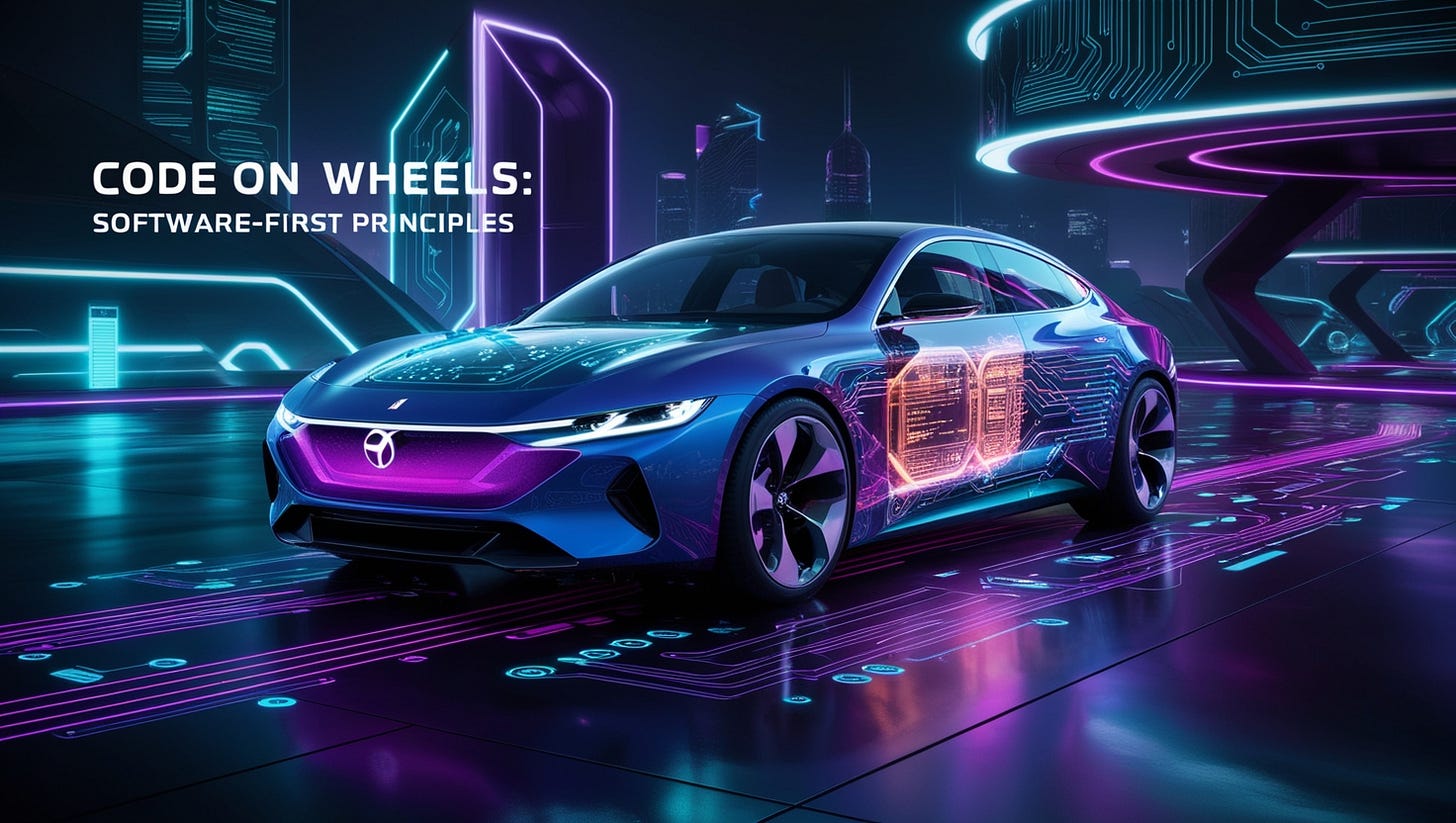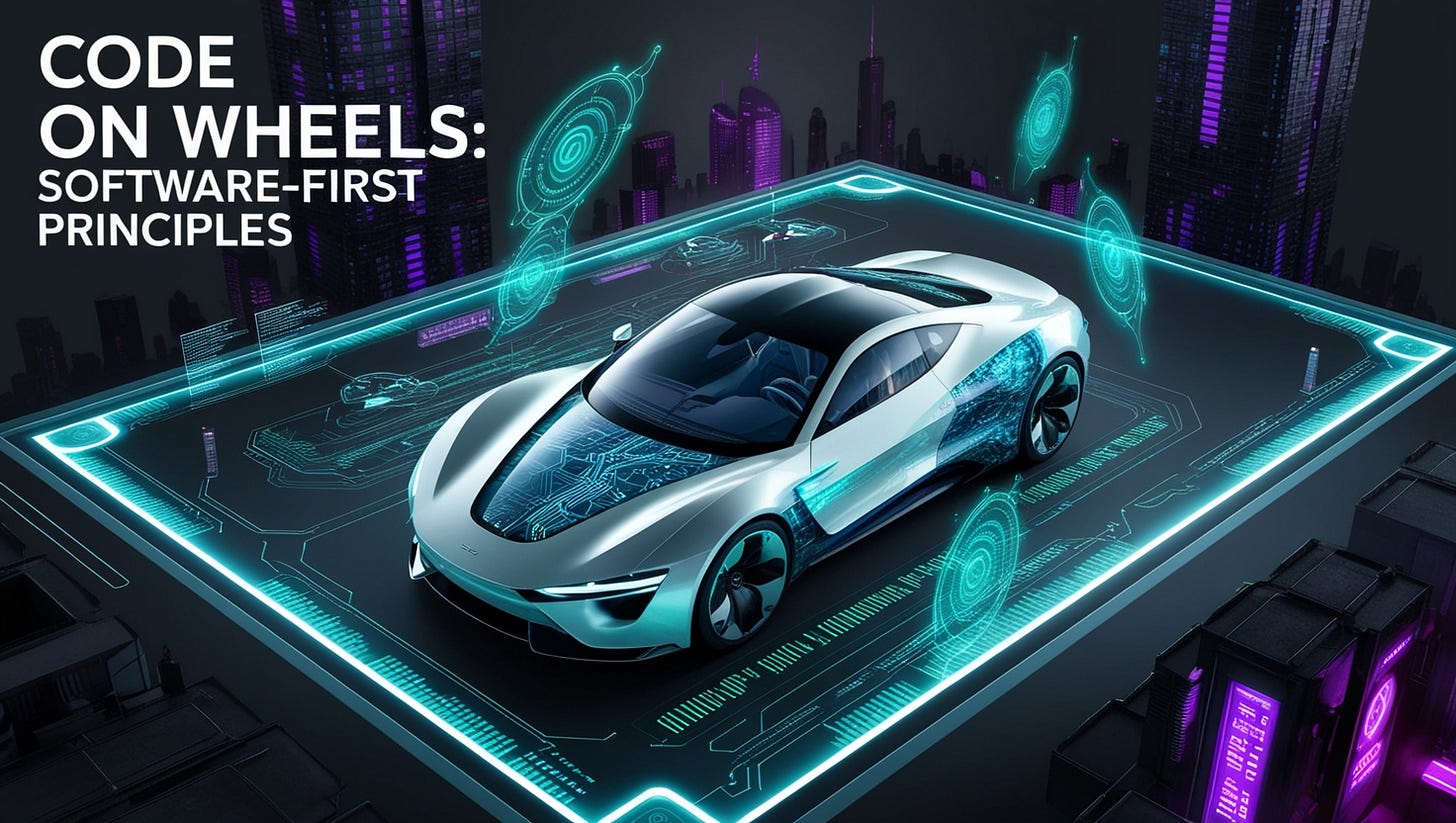Code on Wheels: Rethinking Automotive Software-First Principles
Rethinking Automotive Development: Software as the Starting Point - the emergence of Software-Defined Vehicles (SDVs) demands a fundamental shift: thinking software first and hardware later.
For decades, the automotive industry has been driven by a hardware-first approach, designing vehicles around mechanical and electrical systems before integrating software as an afterthought. However, the emergence of Software-Defined Vehicles (SDVs) demands a fundamental shift: thinking software first and hardware later. This evolution is not solely about new technologies; it requires a complete reimagining of how vehicles are conceptualized, built, and updated.
Rethinking Automotive Development: Software as the Starting Point
A software-first approach begins by defining a vehicle’s capabilities in terms of software architecture, connectivity, and intelligence. Rather than designing hardware first and then shoehorning software into it, forward-thinking automakers envision the user experience, services, and functionalities and then design hardware to support these software-driven goals.
How to Think Software First?
1. Define the Digital Experience First
A crucial initial step is to ask: What should the vehicle experience feel like for the end user? From the moment someone steps into the car, the software defines everything from the infotainment interface to personalized AI-driven cockpit settings. By establishing these digital touchpoints early, manufacturers can ensure that the hardware aligns with the user’s interactive journey.
Example: Tesla fundamentally rethought the cabin experience by centring it around a large touchscreen display. Instead of creating a dashboard and adding a screen later, they let software-driven design guide the interior layout. This approach not only looks modern but allows for feature-on-the-Fly updates that expand and refine infotainment and vehicle controls over time.
2. Prioritize Software Scalability Over Fixed Hardware Constraints
Traditional automotive development often locks in hardware choices at the start, limiting the scope of future software enhancements. In contrast, a software-first philosophy encourages hardware configurations that can be modified or upgraded via software. This flexibility allows vehicles to evolve after rolling off the production line.
Example: Xiaomi Auto’s software-defined parameters enable ongoing improvements to AI features without needing new physical components. By focusing on software scalability, they can continually refine everything from battery management to autonomous driving algorithms.
3. Leverage Cloud and AI for Continuous Development
Viewing the vehicle as a continuously evolving platform is central to software-first thinking. Rather than treating production as the final milestone, automakers can use cloud-based development pipelines and AI-driven analytics to update, enhance, and optimize vehicles long after they’re sold.
Example: NIO taps into real-world driving data to refine features in near real-time. Because their vehicles are connected to the cloud, they can deploy improvements swiftly, from improved battery performance to enhanced driver assistance capabilities.
4. Design Hardware to Serve Software Needs
In a software-first world, hardware becomes a facilitator rather than the focal point. Automakers should design modular computing platforms, reconfigurable sensor arrays, and flexible vehicle electronics to accommodate emerging software requirements.
Example: Tesla’s Full Self-Driving (FSD) capability is underpinned by a specialized neural network chip, developed to handle intensive AI workloads. As Tesla refines its autonomous algorithms through ongoing software enhancements, the hardware foundation remains robust enough to support increasing computational demands.
5. Build for API-Driven Interoperability
A software-first approach means extending the ecosystem beyond the car itself. By building API-driven interoperability, vehicles can seamlessly connect with mobile apps, cloud services, digital assistants, and third-party developers. This open architecture invites ongoing innovation, rather than locking features behind proprietary systems.
Example: Xiaomi Auto provides an open interface for smartphone integration, digital assistants, and ecosystem apps. This allows app developers to build on top of the in-car platform, delivering new functionalities that can be deployed to vehicles at any time.
6. Embrace CI/CD/CT for Faster Iteration and Quality Assurance
Implementing Continuous Integration (CI), Continuous Deployment (CD), and Continuous Testing (CT) is vital to ensure a swift and reliable software development lifecycle. CI streamlines the merging of code changes; CD manages rolling out new features via Feature-on-the-Fly updates; and CT automates testing to maintain quality across different vehicle models.
Example: Tesla’s deployment model relies on rigorous CI/CD pipelines, allowing them to rapidly address issues, add new features, and enhance safety without requiring extensive recalls or in-person visits. The result is a vehicle that grows smarter and more capable over its lifetime.
The New Competitive Advantage: Software-First Thinking
Companies clinging to a hardware-first perspective will find themselves at a disadvantage in a world increasingly governed by code. The defining characteristic of tomorrow’s vehicles will be their capacity to adapt, learn, and expand through software refinements. This shift fundamentally changes how value is perceived: horsepower and body styling matter, but intelligent software is what truly sets a modern car apart.
Moving Forward: Embracing Software-First Development
To thrive in this new era, automakers must rewire their approach:
Start with the digital user experience and design hardware around it.
Adopt cloud-native platforms and AI to drive ongoing vehicle improvements.
Invest in flexible hardware architectures that can accommodate future demands.
Implement CI/CD/CT pipelines for robust, high-velocity software releases.
By prioritizing software-first, hardware-later, automotive manufacturers can ensure their vehicles remain cutting-edge long after they leave the factory. Ultimately, this philosophy will shape the evolution of mobility, transforming cars into continually evolving digital platforms capable of meeting—and exceeding—drivers’ changing expectations.
References:
Tesla Software-Defined Vehicle Approach: https://www.tesla.com/software-updates
Xiaomi Auto and Software-Defined Vehicles: https://www.xiaomi.com/auto/software-platform
NIO Cloud-Connected Vehicles: https://www.nio.com/smart-cloud
CI/CD/CT in Automotive Software Development: https://www.redhat.com/en/topics/devops/what-is-ci-cd
Software-Defined Vehicle Trends: https://www.automotiveworld.com/articles/the-rise-of-software-defined-vehicles
This blog is edited and enhanced with ChatGPT o1 & 4o.
Video Generated by OpenAI Sora, Image Generated by Leonardo.ai



